Top News
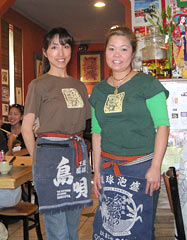
April 23, 2012 Sadao Tome, Correspondent of the Ryukyu Shimpo
In December 2010, Mayumi Tomita Vargas, who is originally from Yonabaru, opened an Okinawan restaurant named Habuya in Orange County, California. She said, “My dream has finally come true after coming to the United States back in 1991.” The restaurant has a distinctly Okinawan atmosphere. Tomita always plays Okinawan music in Habuya, hoping that customers will feel nostalgia for Okinawa as they enjoy the Okinawan home-style cuisine. The word habu in the name of the restaurant has two meanings: one is that of a pit viper found in Okinawa, and the other representing Tomita’s wish for the restaurant to become a hub of the local community.
The restaurant serves authentic Okinawan food as cooked in izakaya, or Japanese-style taverns. Goya chanpuru, an Okinawan stir-fry dish featuring bitter melon, and tebichi, or boiled pig’s trotters, are the most well known dishes on the menu. Soki soba, or Okinawan noodles with spare ribs are also very popular, and some customers who have heard about Habuya through the Internet even come from other regions and states.
Many Okinawan restaurants have opened in the vicinity of Los Angeles in the past, but most of them have ended up closing down. Tomita took this into account, and investigated the realities of the situation, so is confident of managing the restaurant to a successful outcome.
Tomita considered the taste options and the selection of foods on the basis that many Japanese Americans live in Orange County. She included different types of ramen or noodles on the menu. She feels confident that the restaurant would be successful if it could achieve excellent service. Tomita supervises two Japanese cooks in Habuya, which targets a wide range of customers such as Japanese, Chinese and Korean and American. Articles in the Los Angeles Times and other local newspapers that give the restaurant favorable reviews are stuck up on the wall. One day a reporter suddenly appeared without any prior notice and ordered soki soba, and then a couple of days later that reporter named Habuya as the restaurant of the week.
Although Habuya is a relatively small restaurant, seating only about 20 people, it is always crowded with regular customers. Tomita wears a T-shirt which says: “No mongooses,” because the animal is the natural enemy of the habu, or pit viper.
Huntington Beach resident Takahiro Mafune ordered soki soba. He said, “The spare-ribs are delicious and not at all fatty. The food is so good that I will never forget it. I want to come back again sometime soon.”
(English translation by T&CT, Mark Ealey)
Go to Japanese
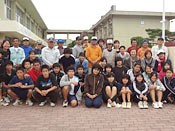
April 18, 2012 Correspondent Kyoko Agarie of the Ryukyu Shimpo
Twenty-three first-year junior high school students placed 29 haiku stone tables at various locations around Izena Island. The haiku poems were written as part of a project with their homeroom teacher Ikuko Ueno when they were second-grade students at elementary school. Six years later, with the help of their parents, the wish of students and their teacher to place the stone tables on Izena has finally been realized.
Students and parents worked together to put the stone tables in place. Homeroom teacher Ueno, who now teaches at Sesoko Elementary School in Motobu, visited the island for the event. She was emotional as their goal was achieved.
After completing their work, the students held a party in the gymnasium of the seaside park called Fureai. Students presented a bouquet of flowers to their former teacher Ikuko Ueno and Chie Oshiro, who is the homeroom teacher in the second grade at junior high school, and sang the song Hana to the parents who cooperated in the event. They shared the delight of realizing a dream six years after having planned it out.
Students want the tablets to be seen by villagers and tourists and Ueno’s stone table was placed by the port. It says: “Summer has come. You are home, sounded the whistle.”
(English translation by T&CT, Shinako Oyakawa and Mark Ealey)
Go to Japanese

April 25, 2012 Ryukyu Shimpo
The United States Government will deploy the MV-22 Osprey vertical take-off and landing transport aircraft to the U.S. Marine Corps Air Station Futenma in July, earlier than stated in the original planned timing of autumn this year. On April 24, several Japanese government officials confirmed that the U.S. Government had informed Japan of the possibility of earlier deployment.
While a Marine Corps MV-22 Osprey crashed in Morocco this month, with the cause of the accident still under investigation, the Corps will deploy the aircraft to Okinawa without waiting for the findings of the investigation. According to the initial deployment plan, the Government of Japan and the U.S. Government had discussed temporary deployment to U.S. military bases on the main islands of Japan prior to placing them at the Futenma base. However, this option was canceled because of opposition from local people and municipalities around those bases in the main islands, and the U.S. government decided to deploy the aircraft directly to Futenma. The Ginowan Municipal Office, the Okinawa Prefectural government and local residents have been increasing their opposition to the early deployment of the Osprey, because they question the safety of the Osprey and have requested that the governments of the United States and Japan abandon the deployment of the Osprey to Futenma.
The Marine Corps Public Affairs Office in Okinawa commented to the Ryukyu Shimpo that the aircraft would be in place by the end of September, but declined to give a more concrete timeline because a formal decision is yet to be made by the government. However, the United States conveyed the earlier deployment plan to Japan during an information exchange session, and Japan is to accept the plan offered by the United States Government.
In the Marine Corps Aviation Plan the Corps stated that it would deploy the Osprey to Futenma in October 2012, but officials have since decided to bring the deployment forward to July for reasons including training and operational missions. In addition, the Marine Corps is concerned about the age of the medium-sized CH-46 transport helicopters currently deployed at Futenma. An official announcement regarding the timing for deployment of the Osprey is to be arranged between two governments. It will be made following the Okinawa Prefectural Assembly election in June, because the governments want to avoid it impacting upon the election.
The U.S. Marine Corps initially will deploy just a few aircraft to Futenma and in the course of time a dozen aircraft will be relocated there. The total number will to increase to 24 aircraft.
(English translation by T&CT, Mark Ealey)
Go to Japanese

April 20, 2012 Ryukyu Shimpo
On April 20, the “Protest rally against Japan’s participation in talks on the Trans-Pacific Partnership Trade Agreement (TPP) was held at Tedako Hall in Urasoe in order to protect food, agriculture and people’s livelihoods in Okinawa.
According to the organizers, the Okinawa branch of the Food, Agriculture, Forestry, Fisheries and Environment Forum, 1000 protesters participated in the rally, including people involved in agriculture, forestry and fisheries, freight companies and healthcare practitioners.
A representative of the rally pointed out that Japan’s participation in TPP could lead to the elimination of tariffs and the abolition of regulations for medical care, finance and public projects as well as undesirable amendments to these, which could have a great impact on the lives of people in Okinawa and its remote islands. The rally adopted a resolution strongly opposing Japan’s participation in the TPP talks without national debate.
(English translation by T&CT, Mark Ealey)
Go to Japanese
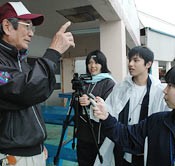
April 19, 2012 Ryukyu Shimpo
The broadcasting club of Okinawa Prefectural Hentona High School has been making a film about the Okinawa movement to revert to Japanese sovereignty. Masataka Nozato and Mikiko Sakugawa, who are second-year students and members of the club, came to know about the movement when they were asked to act as host and hostess at the 40th anniversary ceremony of the Okinawa reversion to be held in Kunigami. The members of the club have listened to stories from those involved back at that time, and they want to understand more and tell young people about what they have heard. The club will submit the film to the All-Japan High School Broadcasting Contest run by NHK in June. On April 15, at the Cape Hedo in Kunigami, the club members commenced their coverage by filming the meeting of former schoolteachers and assembly members who participated in the Okinawa reversion movement. For the last 18 years, the people at the meeting have carried out the repainting of the inscriptions on the monument in commemoration of the Okinawan struggle for reversion to the mother country. This year, the students helped with the repainting of the inscriptions.
The people at the meeting explained to the students about the long-awaited reversion from U.S. military occupation and their disappointment after returning to Japanese administration, with the U.S. bases still being left behind.
Kazuo Uehara, the chairperson of the meeting said to the students, “I hope that today’s young people will create peace.”
After the interview, Nozato realized that the struggle still now continues to achieve real reversion. Riona Kinjo said, “We must do our best to respect the feelings of Uehara-san and other members.”
(English translation by T&CT, Lima Tokumori and Mark Ealey)
Go to Japanese
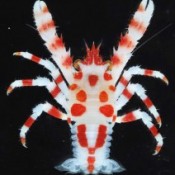
April 18, 2012 Ryukyu Shimpo
On April 17, the Okinawa Churaumi Aquarium announced that the unfamiliar galatheoidea (a superfamily of decapod crustaceans comprising some squat lobsters and porcelain crabs) that they found is a new species of galathea, or squat lobster. The staff member of the aquarium who discovered the new galatheoidea, Takuo Higashiji, and a researcher carried out a joint study and posted an article on it in an academic journal about zoological classification. Using the word chura, which means beautiful in Uchinaguchi, they named it Galathea Chura after its beautiful body, which is white with red spots.
Galathea Chura is only about 15 millimeters long. Last July, about one kilometer from the coast in Onna, Higashiji found the specimen when he was collecting creatures for display using an unmanned submersible on the seafloor at a depth of 188 meters.
Galatheoidea is closely related to the hermit crab. To date 19 species of galatheoidea have been identified around the Ryukyu Islands, and so the Galathea Chura is the twentieth.
Higashiji said, “Most Galatheoidea are brown so the Galathea Chura is rare in that it has pretty colors. We have never previously been able to research in the deep waters around Okinawa, so there is possibility of discovering new strains in future.”
(English translation by T&CT, Lima Tokumori and Mark Ealey)
Go to Japanese

April 20, 2012 Ryukyu Shimpo
Twenty-seven year-old reggae dancer I-VAN, who is originally from Ginowan but currently lives in Jamaica, will take part in the World Reggae Dance Championship held in Jamaica this April, for the fourth time in a row. Although I-VAN missed out on winning a prize in 2010 and 2011 he intends to have a go again saying, “I want to enjoy the competition this year without being concerned about winning.”
I-VAN traveled to Jamaica by himself in 2003. After coming second in the 2009 championship, he was asked to become a goodwill ambassador for Jamaica and went on to become a star there. For this year’s competition, I-VAN formed a team consisting of five Japanese living in Jamaica. He gives us an idea of his natural skills as an entertainer, when he says, “I have ideas about how to get a laugh.”
I-VAN is scheduled to perform in Shanghai in May, which will be the first step towards tapping into continental Asia. He will then perform on a European tour in September for the second time. While I-VAN actively performs all over the world, next summer he intends to make Okinawa his base, planning to perform at all the universities in Okinawa, and suggesting a “School Party,” in which high-school students can come to his performances for just one 500-yen coin. Speaking with confidence and passion he tries to come up with ideas to tell young people to aspire to a dream instead of the desire to have money.
(English translation by T&CT, Mark Ealey)
Go to Japanese
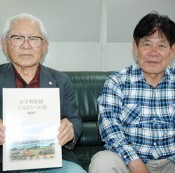
April 14, 2012 Ryukyu Shimpo
Eighty-three year-old Zenryo Iha released a photo collection entitled, “Kouri Bridge, the road to my hometown,” which chronicles the construction of the Kouri and Warumi bridges. The book features 80 photographs taken by Iha and 15 essays written by the children of Kouri Island. With this he passes down local memories to the next generation.
Because he was involved in the building industry, Iha followed the work on the bridge with great interest and documented the construction of the two bridges: Kouri Bridge 1999-2005 and Warumi Bridge 2006-2010.
Junior high school students recorded their thoughts in essays, writing, “I was moved to see the bridge’s beautiful reflections in the setting sun,” and “The bridges have made our lives easier. They bring people together.”
Iha said, “I was attracted by bridges that bring happiness into our lives. I think that I have lead a full life having been able to leave behind these valuable memories. I hope that the children who wrote the essays grow up healthy and strong.
The photo collection will be sold for 1300 yen at bookstores in Nago and at the Nakijin Municipal Office.
(English translation by T&CT, Shinako Oyakawa and Mark Ealey)
Go toJapanese
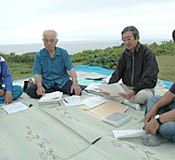
April 17, 2012 Ryukyu Shimpo
On April 15, a discussion group consisting of former politicians and teachers involved in the reversion movement carried out their annual clean-up and repainting of the movement monument at Cape Hedo. Afterwards a meeting was held to discuss the fact that 40 years have passed since the reversion. The participants commented that U.S. military bases still remain in Okinawa and nothing has really changed apart from their passports.
In 1995, the repainting of the inscription of the monument was initiated by a leader of the group, 76 year-old Kazuo Uehara, who was concerned about letters the fading away.
Besides Uehara, residents of Kunigami Village and Ogimi Village Hiroyasu Chibana, Seiji Yamashiro, Hironobu Ota, Kenichi Kinjo, all in their sixties and seventies, participated in the meeting.
Yamashiro reflected on his memories of before the reversion when he took his children to Cape Hedo and looked across the sea, saying, “Over there is our motherland. You are Japanese.”
But at the same time, Ota said, “I am not happy that the reversion still leaves military bases in Okinawa. I feel that I am Ryukyuan rather than Japanese.”
(English translation by T&CT, Megumi Chibana and Mark Ealey)
Go to Japanese

April 19, 2012 Ryukyu Shimpo
Twenty-five years have passed since Tetsuhiro Hokama, president of the Okinawa Gojuryu Kenshi Kai Karatedo Kobudo Association, opened a private karate museum in Nishihara. The museum exhibits more than 400 items related to Okinawan karate. Hokama diligently collected these items to avoid their significance being lost upon society. Exponents of karate who came to study the martial art in Okinawa, where it originates, have visited the museum from about 140 different countries and regions and the total number of visitors has now exceeded 3000 people. Hokama pledges to continue his efforts to support the global tradition of Okinawan karate.
Hokama started to learn karate at the age of eight. When he was at university he realized that materials related to Okinawan karate had not been systematically collected, so ever since he has collected such materials while working as a teacher in commercial high schools. In January 1987 he went on to open a museum in the Yonashiro area of Nishihara and 18 years ago he moved to Uehara, still in Nishihara, where he built a dojo on the first floor of his house with the museum above it on the second floor.
Materials related to karate on display include photographs of past exponents, kobudo gear and documents as well as posters. Hokama said, “It is important to appreciate the position karate has occupied in the history of the Ryukyuan society.” The museum exhibits models explaining aspects of the lives of people in ancient Okinawa, agricultural tools and geta (a form of traditional Japanese footwear) made of stone. Hokama carefully stores patches of karate jackets that the visitors from other countries left behind, and admission tickets of karate contests held in Okinawa, which make the museum unique.
Hokama travels to the United States and Europe to instruct karate between three and six times a year. He also teaches in his dojo twice a week, and is dedicated to passing on the essence of Okinawan karate, which has now spread all over the
world.
(English translation by T&CT, Mark Ealey)
Go to Japanese
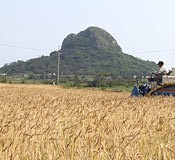
April 13, 2012 Correspondent Yukito Kinjo of the Ryukyu Shimpo
Now is the wheat harvest season on Ie Island, the only place where wheat is grown in Okinawa. The season started from the end of March, and goes through until the beginning of May. Waves of golden wheat sway in the wind under the spring sun in the fields of Higashieue on the other side of Gusukuyama Hill. The staff of the Ie branch of the Japan Agricultural Cooperatives Okinawa are now busy harvesting the wheat.
Last year, 34 farmers harvested 16.4 tons of wheat. The wheat will be dried for about ten days and then most of it will be sold locally. On the island, farmers grow wheat mainly for their own consumption, but some will be delivered to bakeries or cake shops on the mainland. Mujinu-tempura that uses the wheat is a typical dish of Ie Island. A local farmer said, “We assure you that this wheat is safe because of our pesticide-free production methods.”
(English translation by T&CT, Mark Ealey)
Go to Japanese











 Webcam(Kokusai Street)
Webcam(Kokusai Street)


